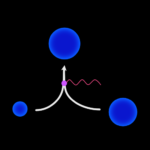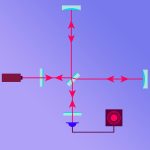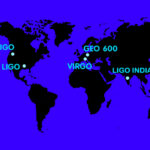Einstein@Home – gravitational waves for everybody
Information on how you personally can help with the search for gravitational wave – by donating processing time on your private computer
An article by Reinhard Prix, Bernd Machenschalk and Benjamin Knispel
Tens of thousands of computer users world-wide hunt for gravitational waves – by donating idle compute cycles on their personal computers. Whenever they are not using the full computing power, their PCs analyze data from the LIGO detectors to search for continuous gravitational waves. A screen saver (see below) allows the volunteers to stay up to date with what data their computers are analyzing and where in the sky the program is currently searching for gravitational waves.
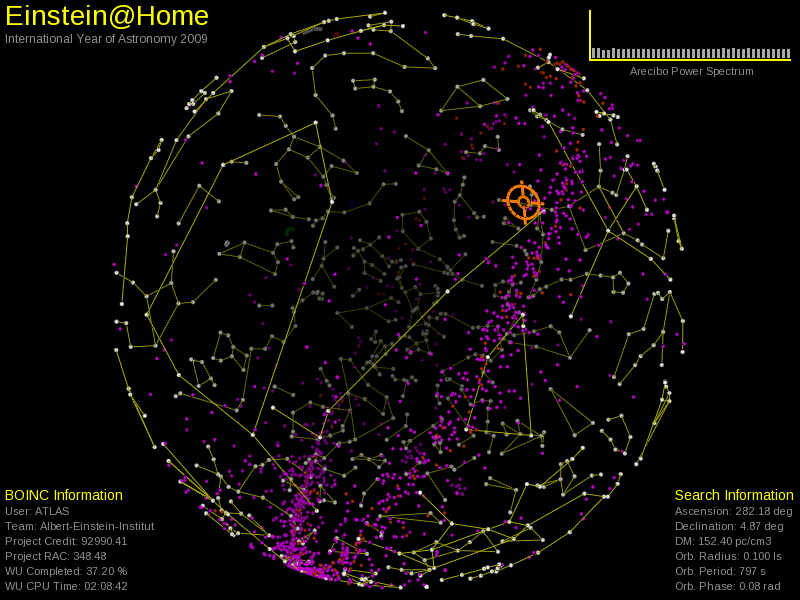
The project that invites users to join the gravitational wave hunt is called Einstein@Home, and the reason for this effort is that the hunt requires immense computing power. This is because in current gravitational wave detectors, the gravitational wave signals from rapidly rotating neutron stars are expected to be very weak compared with the detector noise. To find out whether a gravitational wave is buried in the noise, one can search for gravitational wave signals with a well-known shape, or waveform. This matched filter search – looking for characteristic patterns buried deep within large amounts of noisy data – requires huge computing power.
Waves from rotating neutron stars
The characteristic pattern that Einstein@Home is looking for is a very simple class of gravitational wave signals, which are emitted by rapidly rotating, slightly deformed neutron stars. In order to emit gravitational waves, they must own a slight asymmetry with respect to their rotational axis (for example, stars that have tiny bumps on their surface). Neutron stars are well-known “beasts” to astronomers: about 3000 of them are known as pulsars in our Galaxy. Back-of-the-envelope calculations using the rate of supernova explosions that create neutron stars imply that there should be about 100 million neutron stars in the Milky Way. Where are all of them? Some of the missing neutron stars may only be detectable by measuring the gravitational waves they emit. These waves have a very simple structure – they are emitted as regular continuous sine waves with a frequency twice as large as that of the star’s rotation.
Even though the signal itself is simple, its identification in the detector data is not. First of all, such waves will generically be very weak. Only a long-term search covering long periods of observation can tell whether such weak signals are present in the data or, if none are found, how strong they possibly could have been to escape detection. The weaker the signal, the longer the required observation time. For current gravitational wave detectors, observation times are of the order of months or years.
That leads to the next set of difficulties: During such a long time, the Earth (with the detector on it) rotates around its axis, and moves in its orbit around the Sun. So the detector moves relative to the source, leading to the Doppler effect: relative motion between a wave source and a receiver changes the frequency measured at the receiver. Correspondingly, the gravitational wave frequency changes slightly over time – with the exact nature of the change depending on the position of the gravitational wave source in the sky.
This has an upside and a downside. The upside: One can use the Doppler shift to pinpoint the object’s position in the sky. The downside: the Doppler shift makes the search for signal patterns much more complicated. When looking for the signal from an unknown neutron star, it is not sufficient to look for all the possible different frequencies. In addition, one needs separate search patterns for all possible positions of the source in the sky, which incorporate the possible Doppler shifts. (There is, in fact, one further parameter that hasn’t been mentioned so far: For many neutron stars, the rotation becomes slower over time. After all, the neutron star is converting rotational energy into electromagnetic and hopefully gravitational waves. In searches, one must therefore look for all different possible values of such a decelerated rotation, called “spin-down”, as well.)
The bad news: The resulting number of patterns, or parameter combinations, is so large that even with a supercomputer, a complete search would take an inordinate amount of time. In fact, the available computing power ultimately limits the sensitivity of searches for continuous gravitational waves.
The good news: By its very nature, the search for a great number of different patterns is a problem that can be easily split up into smaller entirely independent work packages. If the amount of data required for each work package is small enough, these may be distributed to a large number of computers via the Internet. Each computer then works on its own subset of patterns. This brings us back to the Einstein@Home project.
Harnessing the power of private computers
Around the world, there are billions of computers in private or commercial use, from privately owned single computers to the computer pools of large companies. Almost none of them are in permanent use – typically, there are many idle periods. A huge potential source of computational power, that is largely untapped. Whoever manages to put even a fraction of that idle time to good use will command a total computing power much larger than that of the world’s supercomputers.
The project which became famous for implementing this ingenious idea on a large scale was “SETI@Home” – the search for radio signals sent by intelligent extraterrestrial beings. Its great success led to the development of a free library named BOINC. Einstein@Home combines BOINC with the search algorithms for the gravitational wave signals of rapidly rotating neutron stars. The software was mainly developed and is maintained at the Max Planck Institute for Gravitational Physics (Albert Einstein Institute, AEI) and at the University of Wisconsin-Milwaukee. Einstein@Home was one of the flagship projects of the American Physical Society for the World Year of Physics 2005. It also was an International Year of Astronomy 2009 project.
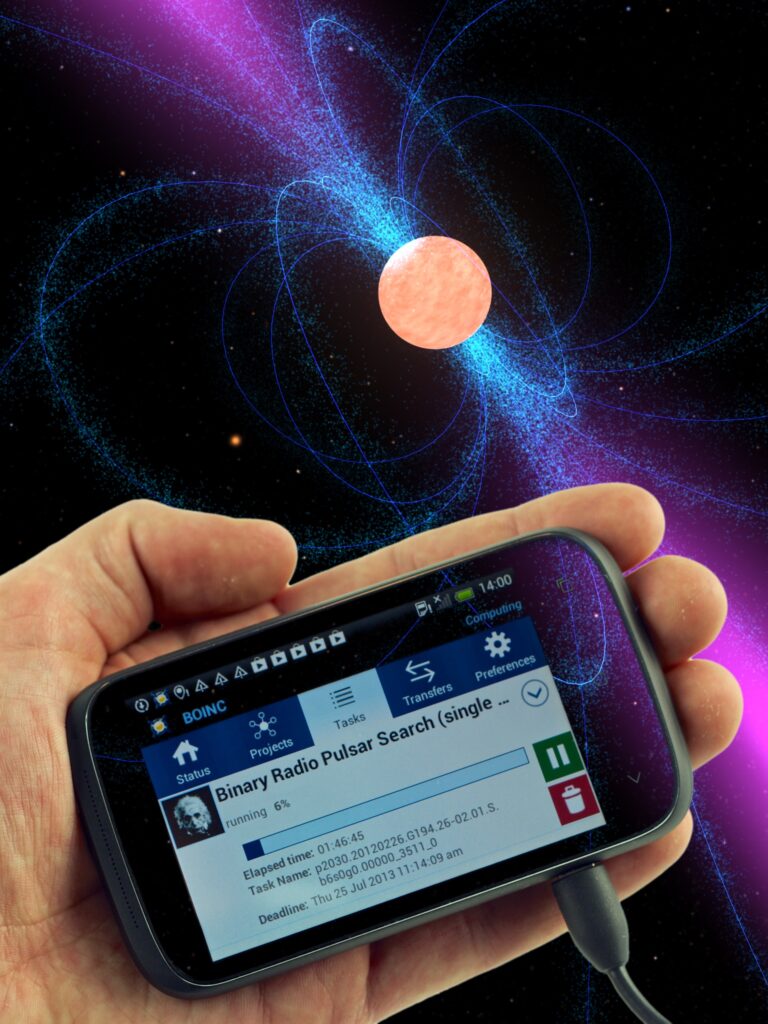
Reach out for the stars and discover new radio pulsars with Einstein@Home on your Android device. Image credit: Max Planck Institute for Gravitational Physics/B. Knispel/NASA
Since its launch in 2005, it has grown to become one of the four largest computing projects in the world, regardless of whether the metric is number of volunteers, computing power, or scientific output in number of published papers.
Although the software that Einstein@Home is based on (BOINC) can manage small to medium size projects, running on a single server computer, a project the size of Einstein@Home with tens of thousands of volunteers and computers active at any given time requires significantly more effort. Einstein@Home features about a dozen server machines.
So how does this work? Once you have signed up and installed the software (to do this, go to the Einstein@Home homepage), the Einstein@Home servers regularly send chunks of data and search codes to your computer. Whenever the computer is not being used, it applies the search algorithms to the data at hand. The results are sent back to the Einstein@Home servers. There is a credit system that allows users, or teams of users, to monitor their contribution to the project; lists of the top participants and teams are maintained on the Einstein@Home website.
As powerful as the largest supercomputers
As of today, 15 years after the project launch more than 500,000 volunteers from all around the globe have contributed compute cycles to Einstein@Home. More than 20,000 users with nearly 35,000 computers and 300,000 CPU cores are active on average. What’s more, some computations are done on almost 15,000 graphics processing units (GPUs) contributed by volunteers. GPUs feature many more computing cores than CPUs which can process data in parallel; for certain types of calculations the lower precision is sufficient and more than offset by the massive computing power provided by GPUs. This has brought the computational power of Einstein@Home to about 6 PetaFLOPs, six quadrillion elementary computations per second on par with the 25 most powerful computers in the world.
The most sensitive search for continuous gravitational waves
The long-term goal of Einstein@Home is the direct detection of continuous gravitational waves. While this direct detection has not been achieved to date, search runs with improving sensitivity provide increasingly better upper limits on the emission of continuous gravitational waves from a Galactic population of neutron stars.
Einstein@Home is the most sensitive all-sky search for continuous gravitational waves in existence. Most recently it has searched public data from LIGO’s second observing run (O2). While fake signals simulated at the LIGO detectors for validation purposes where successfully discovered as expected, no other continuous gravitational waves were found. But even this non-detection is astrophysically meaningful: if the most sensitive search for such signals does not find anything, this information can be turned into a statement about the population of rapidly rotating neutron stars in our Galaxy. For the results from Einstein@Home’s O2 search, this means that there cannot be neutron stars rotating faster than 12,000 rpm being deformed by more than a ten-millionth of their radius within roughly 300 lightyears around the Sun.
Searching for electromagnetic features of neutron stars
In spring 2009, Einstein@Home launched a new search for radio pulsars in binary systems using data from the Arecibo Radio Observatory in Puerto Rico. This work was developed at the AEI in Hanover in collaboration with the PALFA collaboration, then led by Prof. Jim Cordes at Cornell. While this search is intended to find new radio pulsars in sub-hour period binary orbits, it is also sensitive to isolated radio pulsars and to radio pulsars in longer period orbits. Further radio pulsar searches were done in archival data from the Parkes radio telescope. As of today this search has discovered 55 previously unknown pulsars. It currently also runs on ARM-powered devices with Android and Linux operating systems.
Among the radio pulsars discovered with Einstein@Home were several rapidly rotating millisecond pulsars, some in binary systems that allow for tests of Einstein’s general theory of relativity, others that switch their radio emission off from time to time, and some from rare species in the zoo of pulsars.
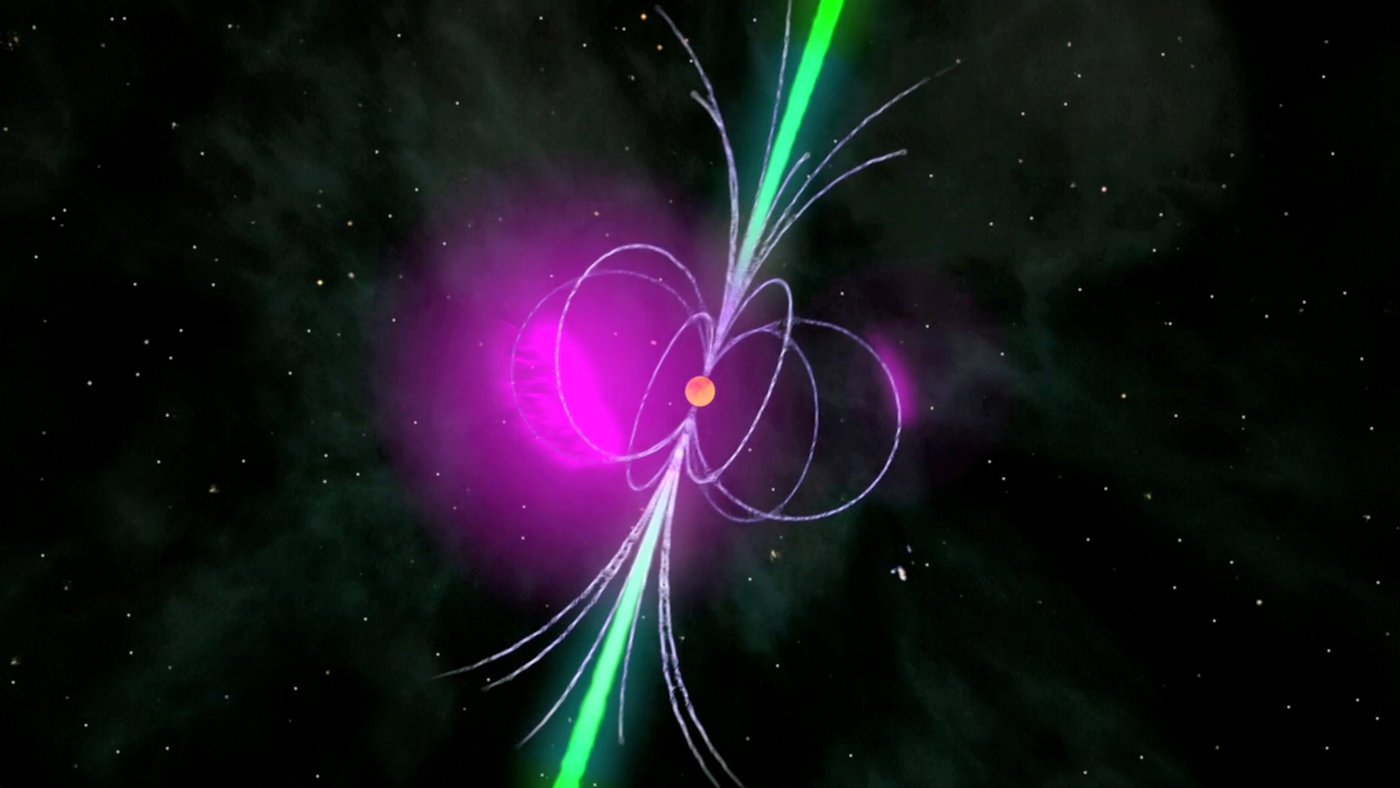
A pulsar is a compact neutron star with an extremely strong magnetic field. The acceleration of particles in this field produces gamma radiation (purple) far above the surface of the compact remains of the star, for example, while radio waves (green) are emitted over the magnetic poles. Image credit: NASA/Fermi/Cruz de Wilde
Since mid 2011, Einstein@Home has also been analyzing data from the Fermi gamma-ray satellite using novel methods that were initially developed for continuous gravitational-wave searches at the AEI in Hanover. As of today, Einstein@Home has discovered 25 new gamma-ray pulsars. There is also a successful search for selected gamma-ray pulsars in binary systems which runs on GPUs provided by the project volunteers.
The gamma-ray discoveries by Einstein@Home include the first millisecond pulsar visible only in gamma rays, an odd couple consisting of a heavy neutron star with a very low mass companion orbiting it, a record-breaking millisecond pulsar in a binary system, a young and energetic neutron star with an unusually irregular rotation, and many more.
Will your computer be the first?
Einstein@Home is constantly refining the search strategy with software development and data analysis working hand in hand to make ever better use of the substantial computing power donated by the volunteers. Einstein@Home is the most sensitive and most powerful tool in the search for continuous gravitational waves. With some luck, your contribution could be crucial in the first ever detection of this elusive type of gravitational waves!
Further Information
For basic information about the relativistic physics touched upon in this article, please refer to Elementary Einstein, in particular to the chapter Gravitational Waves. Related spotlight topics on Einstein-Online can be found in the section Gravitational Waves. For a list of current gravitational wave detector projects, see our spotlight Listening posts around the globe. To reach the web-site of the Einstein@Home project, go to Einstein@Home This article was updated in January 2021. The original from 2010 can be downloaded here.
Colophon
is a scientist at the Albert Einstein Institute in Hannover. His research interests include neutron stars and the detection of gravitational waves. He is one of the developers of the Einstein@Home project.
is a computer scientist at the Albert Einstein Institute in Hannover, where he works on the data analysis of the gravitational wave detectors LIGO and GEO600. He is a major contributor to the Einstein@Home project.
is an astrophysicist and press officer at the Max Planck Institute for Gravitational Physics (Albert Einstein Institute) in Hanover, Germany.
Citation
Cite this article as:
Reinhard Prix, Bernd Machenschalk and Benjamin Knispel, “Einstein@Home – gravitational waves for everybody” in: Einstein Online Band 13 (2020), 13-1001





